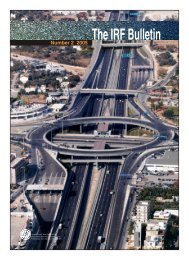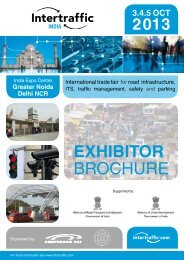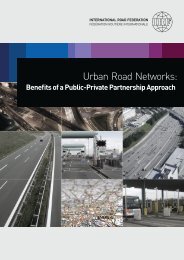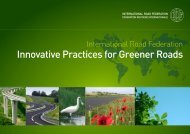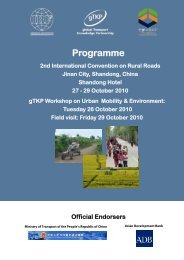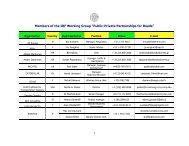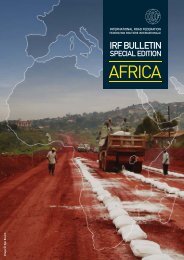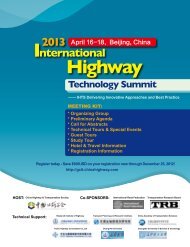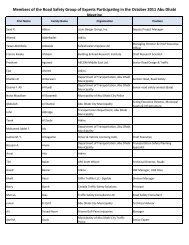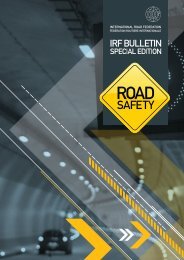TRANSPORT
TRANSPORT
TRANSPORT
- No tags were found...
You also want an ePaper? Increase the reach of your titles
YUMPU automatically turns print PDFs into web optimized ePapers that Google loves.
MANAGEMENT<br />
Effective Policy for Planning<br />
and Management of Rural<br />
Roads<br />
Gerhard P. Metschies<br />
Consultant, formerly with GTZ<br />
Rural Roads (RR) generally represent the lower end of road<br />
standards in a country’s road classification system. They<br />
are often neglected, even though more than 80% of the<br />
population (as in Africa) or more than 60% of the overall<br />
population (as in Asia) still live in rural areas.<br />
Experience has shown that traditional concepts and<br />
approaches may not always lead to lasting success in terms<br />
of addressing such a country-wide problem. In particular,<br />
the ‘basic needs’ approach of individual RR projects at<br />
local and donor level often lacks a stable source of funds,<br />
as well as the organisation of a sustained programme of<br />
maintenance.<br />
Modern concepts, therefore, have to start from the top,<br />
and involve the political will of the President and his<br />
Finance Minister from the outset, before permeating<br />
“downstream“, where the relevant bureaucracy is duly<br />
empowered to overcome the two main bottlenecks<br />
to successful RR projects by securing finance and<br />
organisational capacity.<br />
At the government level, therefore, a number of basic<br />
decisions may be necessary:<br />
Firstly, a so-called ‘road sector approach’ may be needed.<br />
In other words, RR should be considered part of the overall<br />
road transport system of the country (avoiding notions<br />
of “ownership“ on the part of other Ministries, such as<br />
Agriculture, the Interior, etc.). A decision of the Prime<br />
Minister in this respect may be binding over other Cabinet<br />
Ministers.<br />
roads network. For example, if – in the spread of road fund<br />
expenditures – 20% to 25% could be allocated to RR (i.e.<br />
earmarking 2 to 3 Euro cents per litre of fuel tax), it could<br />
solve the most pressing financial problems currently facing<br />
this sector (see figure 1).<br />
Usage of the Road Maintenance Fund<br />
(mostly based on Fuel Tax Revenues as Road Fee)<br />
20% - 25% 70% 10%<br />
Rural Roads Interurban Roads Urban Roads<br />
Thus, more rigid and systematic expenditure allocations<br />
could secure effective financing for RR, as well as ensure<br />
a more certain and reliable basis for detailed forward<br />
planning, notably with respect to (often neglected)<br />
decisions regarding the timing and nature – preventive,<br />
current or periodic – of the maintenance that needs to be<br />
executed.<br />
Thirdly, the existing institutions for national and regional<br />
road systems (Road Fund Agencies and Roads Agencies)<br />
may be complemented by a dedicated Rural Roads<br />
Agency (figure 2). Such a central organisation normally<br />
has responsibility for providing the necessary knowhow,<br />
planning and cost control, as well as technical<br />
standards, bridge plans and so on. It may be progressively<br />
decentralised, or substituted, as and when the requisite<br />
technical engineering and permanent organisational<br />
competence comes into place locally. Later on, modern<br />
asset management systems may be introduced with respect<br />
to all rural road investments in order to secure transparent<br />
investment costs for each individual road, in the form of<br />
road history files. Thus, reliable institutions are an essential<br />
pre-requisite for sustainably resolving the organisational<br />
dimension of the rural roads issue.<br />
Secondly, the basic self-financing principles of the road<br />
sector have to be secured. These include the famous fuel<br />
tax rule that the equivalent of 10 U.S. cents per litre should<br />
be earmarked for road maintenance (agreed, for instance,<br />
at the African Transport Ministers Meeting in Bamako in<br />
2006). Already today, the fuel levy may attain 10 Euro cents<br />
per litre in some countries; and a proportion of this revenue<br />
should be devoted to covering expenses related to the rural<br />
26<br />
| IRF BULLETIN SPECIAL EDITION: RURAL <strong>TRANSPORT</strong>, VOLUME-2



